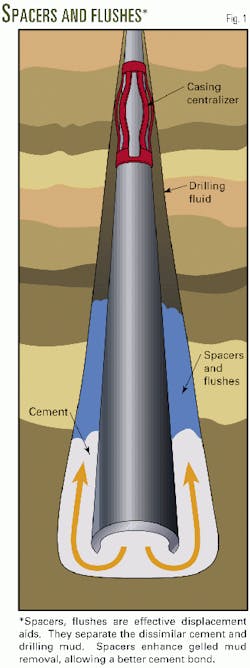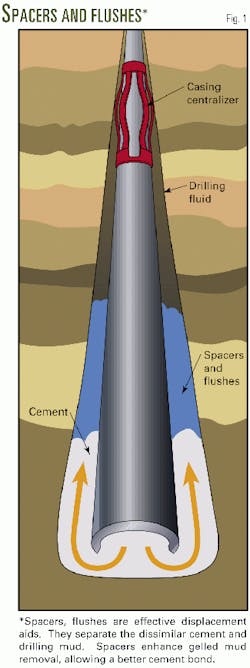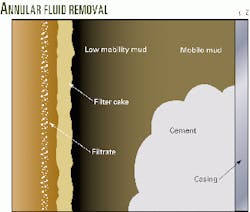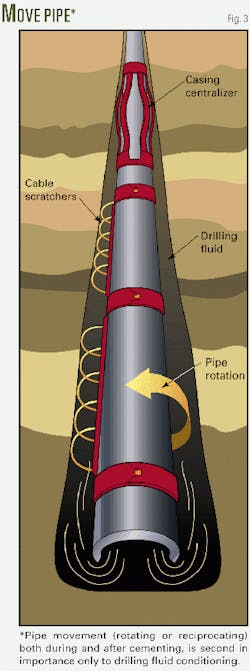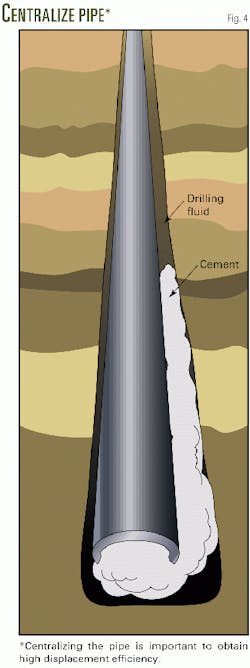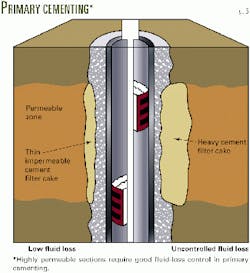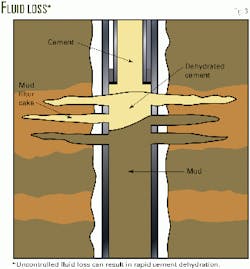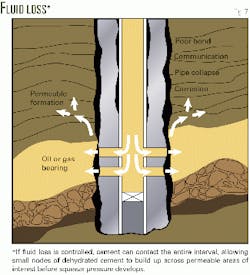In completion of oil and gas wells, cement isolates the wellbore, prevents casing failure, and keeps wellbore fluids from contaminating freshwater aquifers.
The basic factors engineers and operators must consider for successful cementing jobs have not changed in more than 50 years. These factors are summarized in eight basic ideas:
- Condition the drilling fluid.
- Use spacers and flushes.
- Move the pipe.
- Centralize the casing.
- Maximize the displacement rate.
- Design slurry for proper temperature.
- Select and test cement compositions.
- Select a proper cementing system.
The industry has conducted numerous projects over the years to validate the importance of these factors.1-3 The projects have also provided quantitative data for more precisely defining the recipe for good zone isolation.
Drilling fluid
The drilling fluid condition is the most important variable in achieving good displacement during a cement job.
As rig crews pull drill pipe, run casing, and prepare for cementing operations, the drilling fluid in the wellbore essentially remains static and becomes gelled. Pockets of gelled mud, which commonly exist after a wellbore is drilled, make displacement difficult. One must ensure the pockets of gelled fluid are broken up.
Regaining and maintaining good fluid mobility after running the casing is key. Drilling fluids with low gel strengths and low fluid loss are the easiest to displace.
To condition the drilling fluid in preparation for a cement job, operators are encouraged to follow these measures:
- Determine the hole volume that can be circulated. Also, evaluate the percentage of wellbore that is actually being circulated.
Good fluid returns at surface do not reliably indicate the mobility of fluid in the annular space. For best results, use a fluid caliper or material balance to determine downhole fluid mobility and check for annular fluid that is not moving.
- Circulate the drilling fluid to help break the gel structure of the fluid. Condition the drilling fluid until equilibrium is achieved. After the casing is on bottom and before the displacement begins, circulating the mud decreases its viscosity and increases its mobility.
- Never allow the drilling fluid to set static for extended periods, especially at elevated temperatures. When the drilling fluid is well conditioned (the mud properties coming out of the well are the same as the mud pumped in), continue circulating until the displacement program begins.
- Modify the flow properties of the drilling fluid to optimize mobility and drill cuttings removal.
- Examine the mud gel strength profile, during the job planning stage and just before the cement job. Measure gel strengths at 10 sec, 10 min, 30 min, and 4 hr. An optimum drilling fluid will have flat, nonprogressive gel strengths. For example, it will have 6-rpm gel strength values of 1, 3, and 7-lbf/100 sq ft on a Fann 35 viscometer at 10 sec, 10 min, and 30 min, respectively.
- Measure the gel strength development during the job planning stage, at downhole temperature and pressure. Drilling fluid left in the well at elevated temperatures and pressures can gel to a consistency that prohibits removal. These increased gel strengths are not detectable at surface conditions.
Deviated wellbores usually require higher-viscosity drilling fluids to prevent solids from settling on the low side of the hole. Larger drill cuttings in the system also require that higher-viscosity fluids be used. Optimum use of higher-viscosity fluids should be driven by wellbore conditions and inclination.
Spacers, flushes
Spacers and flushes are effective mud displacement aids. They separate the dissimilar drilling fluid from the cement (Fig. 1). Spacers enhance gelled-mud removal and allow better cement bond with the borehole (Fig. 2).
Spacers are designed to serve various needs. Weighted spacers help with well control. Reactive spacers provide increased mud-removal benefits.4 5
Fluid compatibility issues are important. The drilling-fluid, spacer interface and the spacer, and cement-slurry interface must be compatible. Operators are strongly encouraged to use the compatibility procedures outlined in the Recommended Practice for Testing Well Cementing, issued by the API.6
Flow rate, contact time, and fluid properties are parameters that govern spacer effectiveness.
One should consider the following guidelines to achieve maximum mud displacement:
- Pump the spacer fluid at an optimized rate or as fast as possible without breaking down the formation.
- Provide spacer contact time and volume to remove the greatest possible amount of mud.
- Make sure the viscosity, yield point, and density of both the spacer and the cement slurry, are at least the same as the drilling fluid.
- Design the spacer package to water-wet the surface of the pipe and formation thoroughly, when using oil-based or synthetic-based drilling fluids.
Water-wetting the pipe and formation after use of oil-based mud is essential to ensure strong cement bonding. One should test the spacer system using a new API apparent wettability testing technique.1 The technique allows the spacer-surfactant package to be customized, ensuring optimal water-wetting performance.
Flushes are used for thinning and dispersing drilling-fluid particles. These fluids go into turbulence at low rates, helping to clean drilling fluid from the annulus. Flushes generally have densities close to water and may not provide proper well control.
Some chemical flushes such as oxidizers and sodium silicate-based fluids, aggressively attack specific drilling muds, breaking them down and further enhancing drilling fluid removal.
Move the pipe
Rotating and reciprocating casing before and during cementing breaks up stationary, gelled pockets of drilling fluid (Fig. 3). It also loosens cuttings trapped in the gelled mud. Pipe movement allows high displacement efficiency at lower pump rates by keeping the drilling fluid flowing.
Movement compensates partially for poorly centralized casing by changing the flow path and allowing the slurry to circulate completely around the pipe. Mechanical scratchers attached to the casing further enhance the benefits of pipe movement.
The industry has not specified minimum requirements for pipe movement during cementing.
In some instances, reciprocating pipe is not recommended. It can induce surge and swab pressures that promote pipe sticking and surface casing-head pressure. This is particularly true when equivalent circulating density (ECD) and fracture pressures are very similar, or when shallow gas or water influx is critical.
Some liner hangers and mechanical devices prevent casing movement, which must be considered during cement displacement program design.
Centralize
Centralizing casing with mechanical centralizers across the intervals to be isolated helps optimize drilling-fluid displacement. In poorly centralized casing, cement bypasses drilling fluid by following the path of least resistance. Cement travels down the wide side of the annulus, leaving drilling fluid in the narrow side (Fig. 4).
Good pipe standoff helps ensure uniform flow patterns around the casing. Equalizing the friction loss or force that flowing cement exerts around the annular clearance increases drilling-fluid removal.
Standoff is even more critical in deviated wellbores to prevent solids from accumulating in a bed on the low side of the annulus. Operators are encouraged to use computer modeling to develop preferred standoff, which should vary with well conditions.
The best mud displacement at optimum rate is achieved when annular clearances are 1-1.5 in. Centralizing smaller annuli is difficult. Pipe movement and displacement rates are severely restricted. Larger annuli require extreme displacement rates to generate enough flow energy to remove the drilling fluid and cuttings.
Centralizers and other mechanical cementing aids, commonly used in the industry, also serve as inline laminar flow mixers. They change fluid flow patterns and promote better mud displacement and removal.
Displacement rate
High-energy flow in the annulus is most effective to ensure good mud displacement. Turbulent flow around the full casing circumference is desirable, but not absolutely essential.
When turbulent flow is not a viable option for the formation or wellbore configuration, use the highest pump rate that is feasible.
The best cementing results are obtained when the spacer and cement are pumped at maximum energy, the spacer is appropriately designed to remove the mud, and good competent cement is used.
Proper temperature
Operators can optimize slurry design if they know the actual temperature the cement will encounter. Bottomhole cementing temperatures affect slurry thickening time, rheology, set time, and compressive-strength development.
Industry wide, operators tend to overestimate the amount of material required to keep cement in a fluid state for pumping.
Also, there is a tendency to overestimate the pumping time required for a job, which results in unnecessary cost and well-control problems. Most cement jobs are completed in less than 90 min.
One can optimize cost and displacement efficiency by following these guidelines:
- Design the job on the basis of actual wellbore circulating temperatures, obtained from a downhole temperature sub recorder.
- Estimate the bottomhole circulating temperature (BHCT) using the API Recommended Practice for Testing Well Cementing, if actual measurement is not possible.6
- Use the actual downhole temperatures measured. Do not exceed the amount of dispersants and retarders recommended for the wellbore temperature. When determining the amount of retarder required consider the rate at which the slurry will be heated.
- Include surface mixing time when estimating job time, especially if the job is batch-mixed. Calculate the actual job time, using the slurry volume and average displacement rate. Limit the amount of trouble time to 1-1.5 hr. To calculate the approximate thickening time for slurry design, add 1-1.5 hr to the job time.
Cement composition
Operators are encouraged to design a cement slurry for its specific application, with good properties to allow placement in a normal time period.
The ideal cement slurry has no measurable free water, provides adequate fluid-loss control, has adequate retarder to ensure proper placement, and maintains stable density to ensure hydrostatic control.
One should not add dispersants and retarders in excess of the amounts indicated by wellbore conditions. Just enough fluid-loss control material should be added to allow cement placement before it gels (Figs. 5-7).
Several criteria affect slurry design:
- Well depth.
- BHCT.
- Bottomhole static temperature (BHST).
- Drilling fluid hydrostatic pressure.
- Drilling fluid type.
- Slurry density.
- Lost circulation.
- Gas migration potential.
- Pumping time.
- Quality of mix water.
- Fluid-loss control.
- Flow regime.
- Settling and free water.
- Quality of cement.
- Dry or liquid additives.
- Strength development.
- Quality of the cement testing laboratory and equipment.
Before the job, one should check the cement reaction and actual location mix water to ensure the formulation will perform as expected. Contaminants in the mix water can produce large variances in thickening time and compressive strength.
Organic materials and dissolved salts in mix water can affect slurry setting time. Organic materials generally retard the cement. Inorganic materials generally accelerate cement thickening.
Raw materials and plant processing methods vary widely and can cause cement quality to vary.
Cement dehydration from the loss of filtrate to permeable formations can cause bridging and increased friction pressure, viscosity, and density. Pump pressures can increase. Additives can be used to provide fluid-loss control when necessary to compensate for dehydration.
Cementing system selection
Operators select cement systems on the basis of job objectives and well requirements.
Cement is basically inelastic. Cementing systems are similar in many ways. These systems vary, however, in their capability to provide good zone isolation in changing environments. The traditional approach to cement selection has been on the basis that higher compressive strengths result in higher cement sheath quality.
Today, research has proven that the ability of cement to provide good zonal isolation is better defined by other mechanical properties. Good isolation does not necessarily require high compressive strength. The real competence test is whether the cement system in place can provide zone isolation for the life of the well.
Field studies and laboratory research have shown that a cement sheath can lose its capability to provide isolation because of inelasticity. Annular fluid movement between zones and abnormally high annulus pressures indicate failure.
Cement failure can be observed in any area of excess flowing temperatures at the surface of wellbores in which excessive internal casing test pressures are used.
Applications in which cement sheath failure is a concern require the use of systems that can withstand wellbore stresses. Some cement additives impart ductile properties to cement and improve stress tolerances.
One of the most versatile systems to apply is foam cement, which produces a more ductile and resilient cement and withstands the stress associated with casing expansion and contraction.
Researchers discovered that cement with approximately 25% foam quality can have the ductility and resiliency to expand and contract with the casing.
Special considerations
Cementing in deep water demands consideration of a more challenging set of cementing criteria. The design considerations for these challenging conditions require considerable effort.
Current industry testing practices found in the API and ISO do not adequately address the additional complexity of deep water cementing.
Cold temperatures, low fracture gradients, and challenging well conditions require development of custom temperature and pressure schedules for each well.
Temperature simulators should be run for each deep-water application. The API and ISO practices do not address the unique temperature and pressure conditions found in deep water environments.
Because of the complexity of deepwater designs, often it is impossible to employ all of the cementing practices noted in this article.
This puts additional emphasis on proper slurry design, having a good grasp on temperatures and paying close attention to the additional challenges of deepwater cementing.
ISO is in the final stages of developing a deepwater cementing document that addresses many of the issues in deep water cementing.
Although the basic factors engineers must consider for successful cementing have changed little in the past 50 years, taking advantage of the experience and technological advances that have occurred greatly benefits the petroleum industry today.
References
- Clark, C.R., and Carter, L.G., "Mud Displacement with Cementing Slurries," presented to the SPE Annual Meeting, San Antonio, Oct. 8-11, 1972.
- Haut, R.C., and Crook, R.J., "Primary Cementing: The Mud Displacement Process," presented at the SPE Annual Technical Conference and Exhibition, Las Vegas, Sept. 23-26, 1979.
- Hartog, J.J., Davies, D.R., and Stewart, R.B., "An Integrated Approach for Successful Primary Cementations," JPT, September 1983.
- Haut, R.C., and Crook, R.J., "Laboratory Investigation of Lightweight, Low-Viscosity Cementing Spacer Fluids," presented at the SPE Annual Technical Conference and Exhibition, San Antonio, Oct. 5-7, 1981.
- Smith, T.R., and Crook, R.J., "Investigation of Cement Preflushes for a KCl-Polymer Mud," presented at the 33rd Annual Technical Meeting of the Petroleum Society of CIM, Calgary, June 6-9, 1982.
- RP 10B, Recommended Practice for Testing Well Cementing, 22nd edition, API (December 1997; Addendum 2, November 2000).
The authors
Ronald J. Crook is a senior technical advisor in the Zonal Isolation Cementing Group at Halliburton's Duncan Technology Center. He coordinates requests for joint research projects and is a point of contact for technology exchange between various organizations. Crook holds a BS degree in chemical engineering from Oklahoma State University. He has published several technical papers and holds patents in cementing materials and procedures. Crook, a member of SPE, is currently serving on the program committee of SPE/IADC. He also serves on API Committee 10 as chair of publications.
Glen Benge is a senior staff engineer with ExxonMobil Development Company, an ExxonMobil subsidiary in Houston, Tex. He coordinates cementing activities for ExxonMobil's worldwide drilling operations. Benge is a member of SPE, and currently serves as the vice-chairman of API Committee 10 and chairs the group on foamed cement for ISO TC 67/ Subcommittee 3. He has authored numerous technical papers for SPE and industry publications.
Ronnie Faul is a technical professional for Halliburton's new global Deepwater Solutions Team in Houston specializing in deepwater cementing. He has worked 27 years with Halliburton in South Louisiana, South Texas, and the Gulf Coast. He is a 1973 graduate of McNeese State University with a degree in electrical engineering and a member of SPE and AADE.
Richard R. Jones is a principal cementing technical consultant for Outpost Enterprises Inc., Duncan, Okla. He joined Outpost after serving 27 years in various field and research and development positions with Dowell Schlumberger and ARCO E&P Technology. Jones holds a BS degree in chemistry and mathematics from Northeastern Oklahoma State University. Jones is a member of the SPE and retired as Chairman from API Committee 10 in 1999 after receiving the "Citation for Service" for his many contributions to the industry.
Casinghead pressure problems
Chronic sustained casinghead pressure disappoints operators who have successfully drilled and completed a well with economic production rates. Continued operation is jeopardized and remedial action is often expensive and sometimes impossible. Operators attribute most casing annulus pressure problems to poor cementing.
For wells in federal waters of the Gulf of Mexico, the US Minerals Management Service (MMS) rules and regulations, 30 CFR 250.517, concern sustained casinghead pressure. The rules say that casinghead pressures must be reported to the MMS district supervisor by the close of business on the next working day after one discovers the pressure.
The rules allow a well with sustained casinghead pressure that is less than 20% of the minimum internal yield pressure of the affected casing and that bleeds to zero through a 1/2-in. needle valve within 24 hr to continue producing. Diagnostic testing of all casing annuli in the well is required, however, once sustained casinghead pressure is reported.
MMS requires a departure request to be submitted for wells with sustained casinghead pressure greater than 20% of the minimum internal yield pressure of the affected casing or for pressure that does not bleed to zero through a 1/2-in. needle valve.
Once an operator submits a departure request, additional diagnostic testing and reporting is required. One should refer to the MMS for the specific requirements.
If MMS denies the departure request, the well's operator has 30 days to respond with a plan to eliminate the sustained casinghead pressure. Under certain conditions, denials may require shorter time periods for correction of the problem.
About 36,000 wells have been drilled to date in the Gulf of Mexico Outer Continental Shelf waters. Of these, the MMS reports that 11,500 casing annuli in 8,000 wells have had reportable casinghead pressure.
In 2000, the MMS received 672 departure requests for casing annuli pressure problems, of which it processed 632.
Of these requests, MMS allowed 217 wells to continue operation with specific monitoring requirements for a fixed time period, after which a new departure request is required.
Another 238 wells had casing pressures less than 20% of the minimum internal yield pressure of the affected casing. Also, the pressure could be bled to zero and MMS allowed those to continue producing with no further reporting.
MMS allowed continued operation of 30 wells in which the casing pressure was attributed to thermal expansion of annuli fluids.
The MMS denied 112 of the requests, preventing normal well operation and requiring the operator to perform remedial work to resolve the problem. Operators withdrew 35 departure requests.
Currently, the API is working to establish recommended practices specifically for offshore operations, to be issued in three phases.
The first phase is for cementing in deepwater applications. The recommended cementing practice will address the problem of shallow (below mud line) water flow in wells drilled at water depths in excess of 1,000 ft.
The second phase will address cementing applications in water depths less than 1,000 ft, and cover cementing of shallow conductor casing strings. Most reported casing annuli pressure problems involve surface casing strings.
The third phase will address sustained pressures in all casing annuli. The highest reported casing pressures normally are in the production casing strings.
The MMS plans to reference the recommended practices for cementing in their rules and regulations, once they are established, if they meet MMS needs. The effort began in August 2000. The API reportedly is in its third draft. The expectation is that all three phases will be finalized within the next 2 years.
Annular gas migration and sustained casing pressure problems are not restricted to wells in the Gulf of Mexico. It is a problem that can develop in any petroleum basin, worldwide.
